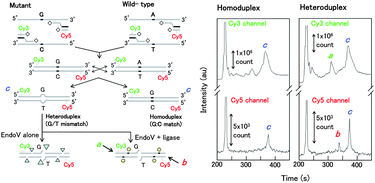We report the ability to detect with high sensitivity sporadic mutations using a mutation scanning assay, which employs thermostable endonuclease V (EndoV) and DNA ligase. The products of the mutation scanning assay were separated using microchip capillary electrophoresis (μCE) and detected with a dual-color laser-induced fluorescence (LIF) detector. PCR products from mutant and wild-type DNA of p53 exon 8 were generated using Cy3-labeled forward and Cy5-labeled reverse primers to allow LIF detection with μCE. EndoV recognizes and primarily cleaves heteroduplexed DNA one base 3′ to a mismatch and can nick matched sites at low levels as well. DNA ligase is used to reseal nicks generated at matched sites, which creates a highly sensitive and specific assay for analyzing sporadic mutations in genomic DNA. Heteroduplexed DNA samples were treated with EndoV alone and with both EndoV and DNA ligase and separated using a 4% (w/v) linear polyacrylamide gel constituted in 1x TTE buffer, 7 M urea, and 0.05% (w/v) methyl hydroxyethyl cellulose, which was used to suppress the EOF in the microchip. Sizing of the bands appearing in the electropherogram revealed the approximate position of the mutation. In this study, mutations present in p53 exon 8 generated Cy3-labeled cleavage products of 158 nt and Cy5-labeled cleavage products of 195 nt. The DNA fragments were simultaneously monitored at their respective color using a dual-color LIF system with the 158 and 195 nt fragments detected along with heteroduplexed fragments of 350 nt. The microchip separation was completed within 7 min, almost ten-fold shorter time compared to conventional capillary gel electrophoresis.

You have access to this article
 Please wait while we load your content...
Something went wrong. Try again?
Please wait while we load your content...
Something went wrong. Try again?


 Please wait while we load your content...
Please wait while we load your content...